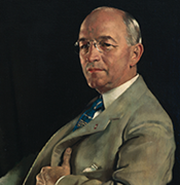Sir William Orpen
1878-1931
Orpen was born in Stillorgan, County Dublin, in Ireland. His parents were amateur painters. At age thirteen, Orpen enrolled in the Dublin Metropolitan School of Art. While there, he won every major prize the school offered, and was also awarded the British Isles gold medal for life drawing. From 1897 to 1899, Orpen studied at the Slade School of Art, where he mastered oil painting and began to experiment with different painting techniques and effects. His teachers were members of the New English Art Club; they ensured Orpen exhibited there and that he became a member in 1900.
From 1903 to 1907, Orpen ran a private teaching studio, the Chelsea Art School. Between 1902 and 1915, he divided his time between London and Dublin, and taught at the Dublin Metropolitan School of Art. He visited Paris and Madrid with his friend and mentor Hugh Lane, who commissioned him to paint a series of portraits of contemporary Irish figures for the Municipal Gallery of Modern Art in Dublin. Beginning in 1908, he regularly exhibited at the Royal Academy.
Between 1911 and 1913, Orpen painted a series of portraits of Vera Brewster, wife of the writer Joe Horne. John Singer Sargent promoted his work, and he soon built a lucrative career in both London and Dublin, painting society portraits. By the start of World War I, Orpen was among the most famous and commercially successful artists in Britain.
Orpen was commissioned into the Army Service Corps and reported for clerical duty in London in March 1916. He continued painting portraits, including one of Winston Churchill. He was made a major and was given indefinite leave to travel to the Western Front as a war artist. There he produced drawings and paintings of ordinary soldiers, fallen men, and German prisoners of war. About 138 of these works were donated to the British government; they are now in the collection of the Imperial War Museum. In 1918, he was made a Knight Commander of the Order of the British Empire. After the war, the Imperial War Museum commissioned Orpen to stay in France and paint three large group portraits of the delegates to the Paris Peace Conference. He was elected a member of the Royal Academy of Arts in 1921.
In later life, Orpen returned to painting society portraits. After his death, memorial exhibitions of his work were held in New York and in London.
Portrait(s) by Sir William Orpen
"*" indicates required fields

